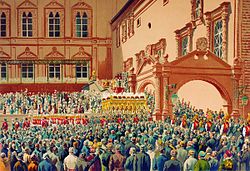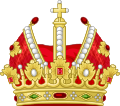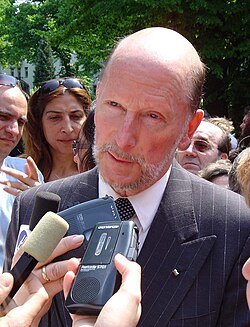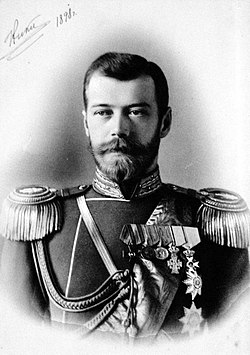Tsar
 From Wikipedia - Reading time: 18 min
From Wikipedia - Reading time: 18 min
This article needs additional citations for verification. (April 2021) |
![[[Alphonse Mucha]]'s The Slav Epic cycle No.4: Tsar Simeon I of Bulgaria (1923)](https://upload.wikimedia.org/wikipedia/commons/thumb/5/5d/Car_Simeon_Bulharsky_-_Alfons_Mucha.jpg/250px-Car_Simeon_Bulharsky_-_Alfons_Mucha.jpg)


| Part of a series on |
| Imperial, royal, noble, gentry and chivalric ranks in Europe |
|---|
 |
| Part of the Politics series |
| Monarchy |
|---|
 |
|
|
Tsar (/zɑːr, (t)sɑːr/; also spelled czar, tzar, or csar; Bulgarian: цар, romanized: tsar; Russian: царь, romanized: tsar'; Serbian: цар, car) is a title historically used by Slavic monarchs. The term is derived from the Latin word caesar,[2] which was intended to mean emperor in the European medieval sense of the term—a ruler with the same rank as a Roman emperor, holding it by the approval of another emperor or a supreme ecclesiastical official—but was usually considered by Western Europeans to be equivalent to "king".[3][4][5]
Tsar and its variants were the official titles in the First Bulgarian Empire (681–1018), Second Bulgarian Empire (1185–1396), the Kingdom of Bulgaria (1908–1946), the Serbian Empire (1346–1371), and the Tsardom of Russia (1547–1721). The first ruler to adopt the title tsar was Simeon I of Bulgaria.[6] Simeon II, the last tsar of Bulgaria, is the last person to have held this title.
Meaning in Slavic languages
[edit]The title tsar is derived from the Latin title for the Roman emperors, caesar.[2] The Greek equivalent of the Latin word imperator was the title autokrator. The term basileus was another term for the same position, but it was used differently depending on whether it was in a contemporary political context or in a historical or Biblical context.
Bulgaria
[edit]

In 705 Emperor Justinian II named Tervel of Bulgaria "caesar" (Greek: καῖσαρ), the first foreigner to receive this title, but his descendants continued to use Bulgar title "Kanasubigi". The sainted Boris I is sometimes retrospectively referred to as tsar, because at his time Bulgaria was converted to Christianity. However, the title "tsar" (and its Byzantine Greek equivalent basileus) was actually adopted and used for the first time by his son Simeon I, following a makeshift imperial coronation performed by the Patriarch of Constantinople in 913. After an attempt by the Byzantine Empire to revoke this major diplomatic concession and a decade of intensive warfare, the imperial title of the Bulgarian ruler was recognized by the Byzantine government in 924 and again at the formal conclusion of peace in 927. Since in Byzantine political theory there was place for only two emperors, Eastern and Western (as in the Late Roman Empire), the Bulgarian ruler was crowned basileus as "a spiritual son" of the Byzantine basileus.[8]
It has been hypothesized that Simeon's title was also recognized by a papal mission to Bulgaria in or shortly after 925, as a concession in exchange for a settlement in the Bulgarian-Croatian conflict or a possible attempt to return Bulgaria to union with Rome. Thus, in the later diplomatic correspondence conducted in 1199–1204 between the Bulgarian ruler Kaloyan and Pope Innocent III, Kaloyan—whose self-assumed Latin title was "Imperator Bulgarorum et Blachorum"—claims that the imperial crowns of Simeon I, his son Peter I, and Samuel were somehow derived from the papacy. The pope, however, only speaks of reges (kings) of Bulgaria in his replies, and eventually grants only that lesser title to Kaloyan, who nevertheless proceeds to thank the pope for the "imperial title" conferred upon him.[9]
After Bulgaria's liberation from the Ottomans in 1878, its new monarchs were at first autonomous prince (knyaz). With the declaration of full independence, Ferdinand I of Bulgaria adopted the traditional title "tsar" in 1908 and it was used until the abolition of the monarchy in 1946. However, these titles were not generally perceived as equivalents of "emperor" any longer. In the Bulgarian as in the Greek vernacular, the meaning of the title had shifted[10] (although Paisius' Slavonic-Bulgarian History (1760–1762) had still distinguished between the two concepts).
Serbia
[edit]
The title of tsar (Serbian car) was used officially by two monarchs, the previous monarchial title being that of king (kralj). In 1345, Stefan Dušan began to style himself "Emperor of Serbs and Greeks" (the Greek renderings read "basileus and autokrator of Serbs and Romans"), and was crowned as such in Skopje on Easter (April 16) 1346 by the newly elevated Serbian patriarch, alongside the Bulgarian patriarch and archbishop of Ohrid. On the same occasion, he had his wife Helena of Bulgaria crowned as empress and his son associated in power as king. When Dušan died in 1355, his son Stefan Uroš V became the next emperor. The new emperor's uncle Simeon Uroš (Siniša) contested the succession and claimed the same titles as a dynast in Thessaly. After his death around 1370, he was succeeded in his claims by his son John Uroš, who retired to a monastery in about 1373.[citation needed]
Russia
[edit]The title tsar was used once by church officials of Kievan Rus' in the naming of Yaroslav the Wise, the grand prince of Kiev (r. 1019–1054). This may have related to Yaroslav's war against Byzantium and to his efforts to distance himself from Constantinople. However, other princes during the period of Kievan Rus' never styled themselves as tsars.[11] The first Russian ruler to openly break with the khan of the Golden Horde, Mikhail of Tver (r. 1285–1318), assumed the title basileus ton Ros,[12] as well as tsar.[13]
Following his assertion of independence from the khan in 1476, Ivan III, the grand prince of Moscow (r. 1462–1505), adopted the title of sovereign of all Russia, and he later also started to use the title of tsar regularly in diplomatic relations with the West.[14] From about 1480, he is designated as imperator in his Latin correspondence, as keyser in his correspondence with the Swedish regent, and as kejser in his correspondence with the Danish king, Teutonic Knights, and the Hanseatic League. Ivan's son Vasily III continued using these titles. Sigismund von Herberstein (1486–1566) observed that the titles of kaiser and imperator were attempts to render the Russian term tsar into German and Latin, respectively.[15][full citation needed] The title-inflation related to Russia's growing ambitions to become an Orthodox "third Rome", after the fall of Constantinople in 1453. The monarch in Moscow was recognized as an emperor by Holy Roman Emperor Maximilian I in 1514.[16][17][note 1]
However, the first Russian ruler to be formally crowned as tsar of all Russia was Ivan IV ("the Terrible"), in 1547. Some foreign ambassadors—namely, Herberstein (in 1516 and 1525), Daniel Printz a Buchau (in 1576 and 1578) and Just Juel (in 1709)—indicated that the word "tsar" should not be translated as "emperor", because it is applied by Russians to David, Solomon and other Biblical kings, who are simple reges.[note 2] On the other hand, Jacques Margeret, a bodyguard of False Demetrius I (r. 1605–1606), argues that the title of "tsar" is more honorable for Muscovites than "kaiser" or "king" exactly because it was God and not some earthly potentate who ordained to apply it to David, Solomon, and other kings of Israel.[18] Samuel Collins, a court physician to Tsar Alexis in 1659–66, styled the latter "Great Emperor", commenting that "as for the word Czar, it has so near relation to Cesar... that it may well be granted to signifie Emperor. The Russians would have it to be a higher title than King, and yet they call David Czar, and our kings, Kirrols, probably from Carolus Quintus, whose history they have among them".[19]

The title tsar remained in common usage, and also officially as part of various titles signifying rule over various states absorbed by the Russian monarchy (such as the former Tatar khanates and the Georgian Orthodox kingdom). In the 18th century, tsar was increasingly viewed as inferior to "emperor" or as highlighting the oriental side of the rank.[20] Upon annexing Crimea in 1783, Catherine the Great adopted the hellenicized title "tsaritsa of Tauric Chersonesos", rather than "tsaritsa of the Crimea". By 1815, when Russia annexed a large part of Poland, the title had clearly come to be interpreted in Russia as the equivalent of Polish król ("king"), and the Russian emperor assumed the title "tsar of Poland".[21]
Among the indigenous peoples of Siberia and the Muslims of the Volga region, Central Asia and the Caucasus, the autocracy of the Russian Empire often became identified with the image of the "White Tsar" (Russian: Белый царь).[22]
By 1894, when Nicholas II ascended the throne, the full title of the Russian rulers was
"By the grace of God Almighty, the Emperor and Supreme Autocrat of all the Russias, Tsar of Moscow, Kiev, Vladimir, Novgorod, Kazan, Astrakhan, Poland, Siberia, Tauric Chersonese, and Georgia, Lord of Pskov, Grand Duke of Smolensk, Lithuania, Volhynia, Podolia and Finland, Prince of Estonia, Livonia, Courland and Semigalia, Samogitia, Białystok, Karelia, Tver, Yugra, Perm, Vyatka, Bulgaria, and other territories; Lord and Grand Duke of Nizhny Novgorod, Chernigov; Ruler of Ryazan, Polotsk, Rostov, Yaroslavl, Beloozero, Udoria, Obdoria, Kondia, Vitebsk, Mstislav, and all northern territories; Ruler of Iveria, Kartalinia, and the Kabardinian lands and Armenian territories; hereditary Ruler and Lord of the Cherkess and Mountain Princes and others; Lord of Turkestan, Heir of Norway, Duke of Schleswig-Holstein, Stormarn, Dithmarschen, Oldenburg".[23]
Montenegro
[edit]The title of Tsar was only used one time in Montenegro, by Šćepan Mali, translated as Stephen the Little. He was rumored to be former Russian Emperor Peter III. He ruled the country of Montenegro as absolute Monarch, and reigned as Tsar of Montenegro from 1768 until his death in 1773. [citation needed]
Metaphorical uses
[edit]Like many lofty titles, such as mogul, tsar or czar has been used in English as a metaphor for positions of high authority since 1866 (referring to U.S. President Andrew Johnson), with a connotation of dictatorial powers and style, fitting since "autocrat" was an official title of the Russian Emperor (informally referred to as 'the tsar'). Similarly, Speaker of the House Thomas Brackett Reed was called "Czar Reed" for his dictatorial control of the House of Representatives in the 1880s and 1890s.[citation needed]
In the United States and in the United Kingdom, the title "czar" is a colloquial term for certain high-level civil servants, such as the "drug czar" for the director of the Office of National Drug Control Policy (not to be confused with a drug baron), "terrorism czar" for a presidential advisor on terrorism policy, "cybersecurity czar" for the highest-ranking Department of Homeland Security official on computer security and information security policy, and "war czar" to oversee the wars in Iraq and Afghanistan. More specifically, a czar in the US government typically refers to a sub-cabinet-level advisor within the executive branch. One of the earliest known usages of the term was for Judge Kenesaw Mountain Landis, who was named commissioner of baseball, with broad powers to clean up the sport after it had been sullied by the Black Sox scandal of 1919.[24]
See also
[edit]- Succession of the Roman Empire
- List of Bulgarian monarchs
- List of Russian rulers
- List of Serbian monarchs
- List of U.S. executive branch czars
- Tsarevets (fortress)
- Tsarina
- Tsarevich
- Tsesarevich
Notes
[edit]- ^ "Kayser vnnd Herscher aller Rewssen und Groszfürste zu Wolodimer" in the German text of Maximilian's letter; "Imperator et Dominator universorum Rhutenorum et Magnus Princeps Valadomerorum" in the Latin copy. Vasily III responded by referring to Maximilian as "Maximiliano Dei gratia Electo Romanorum Caesare", i.e., "Roman Caesar". Maximilian's letter was of great importance to Ivan the Terrible and to Peter the Great, when they wished to back up their titles of "tsar" and "emperor", respectively. Both monarchs demonstrated the letter to foreign ambassadors; Peter even referred to it when he proclaimed himself Emperor.
- ^ Based on these accounts, the Popes repeatedly suggested to confer on the Russian monarchs the title of rex ("king"), if they would only ally themselves with the Pope. Such a proposal was made for the last time in 1550, i.e., three years after Ivan IV had crowned himself tsar. As early as 1489, Ivan III declined the papal offer, declaring that his regal authority did not require anyone's confirmation.
References
[edit]Citations
[edit]- ^ Ivan Biliarsky, Word and Power in Mediaeval Bulgaria, East Central and Eastern Europe in the Middle Ages, 450–1450, Brill, 2011, ISBN 9004181873, p. 211.
- ^ a b "Online Etymology Dictionary". etymonline.com.
- ^ Margeret, J. (1983). The Russian Empire and Grand Duchy of Muscovy. University of Pittsburgh. p. 111. ISBN 9780822977018.
The Slavonic Bible did equate the terms "tsar" and "king"... Russian writers often compared the grand prince or tsar with any kings of the Old Testament. Several writers [argued] that it was a mistake to translate tsar as "emperor". This was important because of a widely held view in Europe that the tsar wished to claim the imperial legacy of the defunct Byzantine Empire.
- ^ de Madariaga, Isabel (2006). Ivan the Terrible. Yale University Press. p. 78. ISBN 9780300143768.
The primary meaning of tsar was thus an independent ruler, with no overlord, who could be either a king of one particular nation or people, as in the Bible, or an 'emperor' ruling over several antions, such as the East Roman Emperor.
- ^ Madariaga, Isabel De (2014). Politics and Culture in Eighteenth-Century Russi. Routledge. pp. 40–42. ISBN 978-1-317-88190-2.
Other powers [forgot] that tsar had once been recognized as Empereur, as imperator, or even as kayzer... This explains much of the difficulty encountered by Peter I when he adopted the title Imperator. The etymological origin of the word tsar had been glossed over and the title had been devalued.
- ^ "Simeon I." Encyclopædia Britannica. 2009. Encyclopædia Britannica Online. 12 July 2009, EB.com.
- ^ Christina Holtz-Bacha, Encyclopedia of Political Communication, Volume 1, with Lynda Lee Kaid, Christina Holtz-Bacha as ed., Sage, 2008, ISBN 1412917999. p. 115.
- ^ Срђан Пириватрић. Самуилова држава. Београд, 1997.
- ^ Innocentii pp. III epistolae ad Bulgariae historiam spectantes. Recensuit et explicavit Iv. Dujcev. Sofia, 1942.
- ^ Найден Геров. 1895–1904. Речник на блъгарский язик. (the entry on цар in Naiden Gerov's Dictionary of the Bulgarian Language)
- ^ Wladimir Vodoff. Remarques sur la valeur du terme "czar" appliqué aux princes russes avant le milieu du 15e siècle, in "Oxford Slavonic Series", new series, vol. XI. Oxford University Press, 1978.
- ^
de Madariaga, Isabel (1997). "Tsar into Emperor: the title of Peter the Great". In Oresko, Robert; Gibbs, G. C.; Scott, H. M. (eds.). Royal and Republican Sovereignty in Early Modern Europe: Essays in Memory of Ragnhild Hatton. Cambridge: Cambridge University Press. p. 355. ISBN 9780521419109. Retrieved 2 October 2023.
[...] Michael of Tver', after receiving the yarlyk (edict) of the Mongol Khan in 1304 as grand prince of Vladimir and Moscow sent an embassy to the Emperor Andronicos II in which he described himself as basileus ton Ros.
- ^ A.V. Soloviev. "Reges" et "Regnum Russiae" au moyen âge, in "Byzantion", t. XXXVI. Bruxelles, 1966.
- ^
Bushkovitch, Paul (2021). Succession to the Throne in Early Modern Russia: The Transfer of Power 1450–1725 (1st ed.). New York: Cambridge University Press. p. 73. ISBN 9781108479349. Retrieved 2 October 2023.
Ivan III had occasionally, not regularly, used the title 'tsar' in letters to other rulers.
- ^ "Den Titel aines Khaisers, wiewol Er alle seine Brief nur Reissisch schreibt, darinn Er sich Czar nent, so schickht Er gemaincklich Lateinische Copeyen darmit oder darinn, und an stat des Czar setzen sy Imperator, den wir Teutsch Khaiser nennen".
- ^ Ostrowski, D. (2002). Muscovy and the Mongols: Cross-Cultural Influences on the Steppe Frontier, 1304–1589. Cambridge, England: Cambridge University Press, p. 178.
- ^ Lehtovirta, J. "The Use of Titles in Herberstein's "Commentarii". Was the Muscovite Tsar a King or an Emperor?" in Kӓmpfer, F. and Frӧtschner, R. (eds.) (2002) 450 Jahre Sigismund von Herbersteins Rerum Moscoviticarum Commentarii 1549–1999, Harrassowitz Verlag, pp. 196–198.
- ^ "Et ainsi retiennent le nom de Zar comme plus autentique, duquel nom il pleut iadis à Dieu d'honorer David, Salomon et autres regnans sur la maison de Iuda et Israel, disent-ils, et que ces mots Tsisar et Krol n'est que invention humaine, lequel nom quelqu'un s'est acquis par beaux faits d'armes".
- ^ The Present State of Russia, in a Letter to a Friend at London. Written by an Eminent Person residing at Great Tzars Court at Mosco for the space of nine years. 2nd ed. London, 1671. pp. 54–55.
- ^ Boris Uspensky. Царь и император: помазание на трон и семантика монарших титулов. Moscow: Языки русской культуры, 2000. ISBN 5-7859-0145-5. pp. 48–52.
- ^ "The Brockhaus and Efron Encyclopedia entry on Tsar". Archived from the original on 2020-09-08. Retrieved 2006-07-27.
- ^
Hofmeister, Ulrich (2017). "From the White Tsar to the Russian Tsar. Monarchy and Russian Nationalism in Tsarist Turkestan". In Banerjee, Milinda; Backerra, Charlotte; Sarti, Cathleen (eds.). Transnational Histories of the 'Royal Nation'. Palgrave Studies in Modern Monarchy. Cham, Switzerland: Springer. p. 137. ISBN 9783319505237. Retrieved 2 October 2023.
[...] White Tsar [Belyi Tsar']. This title was widely used in Russian communication with Asian or Muslim peoples during the nineteenth century and derived its attraction from its 'Asian' appeal. [...I]n late Tsarist times the expression White Tsar was perceived as a specific 'oriental' title for the Russian Tsar that was rooted in Mongolian traditions.
- ^ Harcave, Sidney First Blood The Russian Revolution of 1905 Macmillan: London, 1964 p. 12
- ^ James K. Glassman (December 18, 2000). "Close, But No Big Czar". Reason magazine.
Sources
[edit]- Michael and Natasha, The Life and love of the Last Tsar of Russia, Rosemary & Donald Crawford, Weidenfeld & Nicolson, London 1997. ISBN 0-297-81836-8.
- George Ostrogorsky, "Avtokrator i samodržac", Glas Srpske kraljevske akadamije CLXIV, Drugi razdred 84 (1935), 95–187
- John V.A. Fine Jr., The Early Medieval Balkans, Ann Arbor, 1983
- John V.A. Fine Jr., The Late Medieval Balkans, Ann Arbor, 1987
- Robert O. Crummey, The Formation of Muscovy 1304–1613, New York, 1987
- David Warnes, Chronicle of the Russian Tsars, London, 1999
- Matthew Lang (Editor), The Chronicle – $10 Very Cheap, Sydney, 2009/10
 KSF
KSF